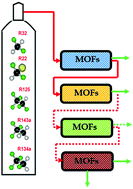Fluorocompounds have important applications in industry, but they are environmentally unfriendly, can cause ozone depletion and contribute to global warming with long atmospheric lifetime and high global warming potential. Hence, reclamation of used fluorocompounds via energy efficient adsorption-based capture and separation will greatly contribute to controlling their environmental release and reduce their impact on the environment. Among the various types of adsorbents, emerging metal organic frameworks (MOFs) display excellent gas adsorption performances. In this review article, we discuss the specific structural, physical and chemical properties of MOFs that lead to the high fluorocompound adsorption capacity, selectivity and regenerability. To rationalize the extremely high adsorption capacities and excellent selectivities, the interactions of various fluorocompound molecules with different functional moieties in MOFs are further discussed. Last but not least, we also highlight the key issues that require further research for industrial scale application of MOFs for fluorocompound separation. Ultimately, we hope that our work will stimulate more studies to understand the fluorocompound adsorption in MOFs in order to design high performance MOFs with optimum adsorption capacity and selectivity for fluorocompound capture and separation.
